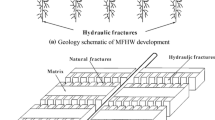We propose a mathematical model describing gas flow from a fractured shale reservoir into a horizontal well. Based on Langmuir adsorption theory and Darcy’s law, we have obtained a basic solution using a combination of a point source function, an integral of a Bessel’s function, and the Poisson summation formula. We plotted typical curves for the dimensionless pressure and its derivative on a log-log scale. We analyze the stages of gas flow from the shale formation to the horizontal well and the factors influencing it.







Similar content being viewed by others
References
C. R. Clarkson and B. Haghshenas, “Modeling of supercritical fluid adsorption on organic-rich shales and coal,” in: SPE Unconventional Resources Conference, Woodlands, Texas USA, April 2013; SPE 164532.
M. Gasparik, A. Ghanizadeh, P. Bertier et al., “High-pressure methane sorption isotherms of black shale from the Netherlands,” Energy & Fuels, 26, 4995-5004 (2012).
Tongwei Zhang, Geoffrey S. Ellis, Stephen C. Ruppel et al., “Effect of organic-matter type and thermal maturity on methane adsorption in shale-gas systems,” Organic Geochemistry, 47, 120-131 (2012).
Philipp Weniger, Wolfgang D. Kalkreugh, Andreas Busch et al., “High-pressure methane and carbon dioxide sorption on coal and shale samples from the Parana Basin, Brazil,” International Journal of Coal Geology, 84, 190-205 (2010).
S. R. Etminan, F. Javadpour, B. B. Maini, and Z. Chen, “Measurement of gas storage processes in shale and of the molecular diffusion coefficient in kerogen,” International Journal of Coal Geology, 123, No. 1, 10-19 (2014).
Ghanizadeh Amin, Matus Gasparik, Alexandra Amann-Hildenbrand et al., “Experimental study of fluid transport processes in the matrix system of the European organic-rich shales: I.,” Scandinavian Alum Shale, Marine and Petroleum Geology, 51, No. 3, 79-99 (2014).
Ghanizadeh Amin, Matus Gasparik, Alexandra Amann-Hildenbrand et al., “Experimental study of fluid transport processes in the matrix system of the European organic-rich shales: II. Posidonia Shale (Lower Toarcian, Northern Germany),” International Journal of Coal Geology,” 123, No. 1, 20-33 (2014).
Daniel J. K. Ross and R. Marc Bustin, “Impact of mass balance calculations on adsorption capacities in microporous shale gas reservoirs,” Fuel, 86, No. 17, 2696-2706 (2007).
Robert Heller and Mark Zoback, “Adsorption of methane and carbon dioxide on gas shale and pure mineral samples,” Journal of Unconventional Oil and Gas Resources, 8, No. 12, 14-24 (2014).
H. Q. Song, M. X. Yu, and W. Y. Zhu, “Numerical investigation of gas flow rate in shale gas reservoirs with nanoporous media,” International Journal of Heat and Mass Transfer, 80, No. 2, 626-635 (2015).
Akand Islam and Tad Patzek, “Slip in natural gas flow through nanoporous shale reservoirs,” Journal of Unconventional Oil and Gas Resources, 7, No. 9, 49-54 (2014).
L. D. Mi, H. Q. Jiang, and J. J. Li, “The impact of diffusion type on multiscale discrete fracture model numerical simulation for shale gas,” Journal of Natural Gas Science and Engineering, 20, No. 9, 74-81 (2014).
L. D. Mi, H. Q. Jiang, and J. J. Li, “The investigation of fracture aperture effect on shale gas transport using discrete fracture model,” Journal of Natural Gas Science and Engineering, 21, No. 11, 631-635 (2014).
Branimir Cvetkovic, Jan Sagen, and Gotskalk Halvorsen, “Modeling the productivity of a multi-fractured horizontal well,” in: SPE Rocky Mountain Petroleum Technology Conference, Keystone, Colorado, May 2001; SPE 71076.
Aissa Zerzar, and Youcef Bettam, “Interpretation of multiple hydraulically fractured horizontal wells in closed systems,” in: International Improved Oil Recovery Conference, Kuala Lumpur, Malaysia, October 2003; SPE 84888.
M. Brown, R. Raghavan, and H. Kazemi, “Practical solutions for pressure transient responses of fractured horizontal wells in unconventional reservoirs,” in: SPE Annual Technical Conference and Exhibition, New Orleans, Louisiana USA, 4–7 October 2009; SPE 125043.
Bruce R. Meyer, Lucas W. Bazan, and R. Henry Jacot et al., “Optimization of multiple transverse hydraulic fractures in horizontal wellbores,” in: SPE Unconventional Gas Conference, Pittsburgh, Pennsylvania USA, February 2010; SPE 131732.
Imad Ghani Brohi, Mehran Pooladi-Darvish, and Roberto Aguilera, “Modeling fractured horizontal wells as dual porosity composite reservoirs: Application to tight gas, shale gas and tight oil cases,” in: SPE Western North American Region Meeting, Anchorage, Alaska USA, May 2011; SPE 144057.
E. Stalgorova and L. Mattar, “Analytical model for history matching and forecasting production in multifrac composite systems,” in: SPE Canadian Unconventional Resources Conference, Calgary, Canada, November 2012; SPE 162516.
J. J. Ren, P. Guo, D. L. Wand et al., “Productivity model of fractured horizontal wells in shale gas reservoirs and analysis of influential factors,” Journal of Northeast Petroleum University, 6, No. 12, 34-42 (2012).
J. Deng, W. Y. Zhu, and Q. Ma, “A new seepage model for shale gas reservoir and productivity analysis of fractured well,” Fuel, 124, No. 15, 232-240 (2014).
Author information
Authors and Affiliations
Corresponding author
Additional information
Translated from Khimiya i Tekhnologiya Topliv i Masel, No. 2, pp. 65 – 70, March – April, 2016.
Rights and permissions
About this article
Cite this article
Li, Cy., Zhou, J., Luo, Y. et al. Nonlinear Model for Gas Flow into a Horizontal Well from a Shale Reservoir with a Branched Fracture Network. Chem Technol Fuels Oils 52, 224–236 (2016). https://doi.org/10.1007/s10553-016-0694-1
Published:
Issue Date:
DOI: https://doi.org/10.1007/s10553-016-0694-1




